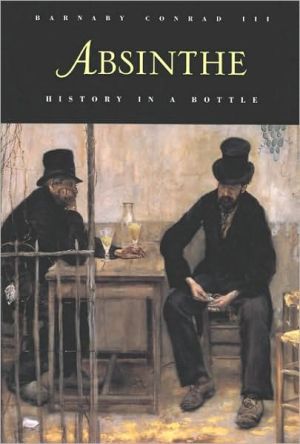Absinthe: History in a Bottle
One hundred forty-four proof, notoriously addictive, and the drug of choice for nineteenth-century poets, absinthe is gaining bootleg popularity after almost a century of being banned. Due to popular demand, Absinthe: History in a Bottle is back in paperback with a handsome new cover. Like the author's bestselling The Martini and The Cigar, it is a potent brew of wild nights and social history, fact and trivia, gorgeous art and beautiful artifacts. As intoxicating as its subject, Absinthe...
Search in google:
One hundred forty-four proof, notoriously addictive, and the drug of choice for nineteenth-century poets, absinthe is gaining bootleg popularity after almost a century of being banned. Due to popular demand, Absinthe: History in a Bottle is back in paperback with a handsome new cover. Like the author's bestselling The Martini and The Cigar, it is a potent brew of wild nights and social history, fact and trivia, gorgeous art and beautiful artifacts. As intoxicating as its subject, Absinthe makes a memorable gift for anyone who knows how to celebrate vice. Publishers Weekly Few drinks conjure the cultural associations and charged atmospheres that absinthe does, even now, some 70 years after its ban in Europe and the U.S. Freelance writer Conrad sees absinthe ``as a skeleton key to the fin de siecle's secrets.'' An engaging combination of art history, sociology, travelogue and artists' biography, this clever hybrid recounts both the praise heaped upon the alcoholic beverage and the tales of destroyed creativity and absinthe-related violence that led to its prohibition. Turn-of-the-century Paris comes alive, as does its expatriate society of the '20s. Oil paintings, etchings and artifacts with absinthe themes by Manet, Van Gogh, Lautrec and others adorn the pages, and quotes and anecdotes about the green liqueur by Wilde, Baudelaire and Hemingway fill the well-researched text. More sober chapters include ``The Origins of Ancient and Modern Absinthe'' and ``Absinthe and Politics,'' which links certain temperance movements to anti-Semitism. Like its subject, this volume is addictive and enchanting. (Dec.)
\ From the PublisherA lavishly illustrated, hugely enjoyable account of la f e verte. Gourmet\ . . . juicy anecdotes about famous artistic absintheurs: Early Symbolists like Beaudelaire, Rimbaud and (to show that even Americans could be decadent) Poe. Los Angeles Times\ \ Absinthe, as reviled in its time as crack cocaine is today, now seems the rather quaint forbidden fruit of a more innocent age. We think of fin-de-si cle poets guzzling it in stagy despair or old paintings of stoned-out Parisians who don't look as if they're having that much fun slouched over their liqueur glasses.\ But absinthe-drinking certainly was a drug scene. A serious absintheur would add the water to the liqueur slowly, pouring it over a sugar cube in an elaborate slotted spoon with a ritualistic absorption that reminds us of a junkie shooting up.\ Like its non-scandalous descendant, Pernod, absinthe turned milky when mixed with water, with an opalescent greenish tone. Emerald green came to have the same implication of druggy ecstasy in the art of the 1890s that paisleys and mandalas had in the psychedelic '60s.\ There is a curious history here, and Barnaby Conrad III recounts a lot of it in this fascinating book first published in 1988 and recently reissued by Chronicle Books. One of the things he makes you wonder is how people ever got addicted to a drink made from wormwood (apsinthium), a proverbially bitter herb best known as an insect repellent and cure for worms. Wormwood was an ingredient in many of the hopefully medicinal liqueurs people had been concocting since the Middle Ages. (Another of them, vermouth, actually gets its name from wormwood.) The one named absinthe had been made since the 1760s but didn't become controversial until a hundred years later.\ The absinthe cult began, as Conrad explains, in the 1840s, when the French government issued absinthe to soldiers stationed in Algeria as a fever preventive. Some of them took to drinking it, let us say, recreationally and brought the custom back to Paris with them.\ In the end, it became the symbol of decadence at a time when decadence was taken very seriously. As a result of the clamor, it was illegal just about everywhere by World War I. It is the only alcoholic beverage ever singled out by law as uniquely dangerous.\ Along the way, many writers and painters had been seduced by absinthe. Most of Conrad's book consists of juicy anecdotes about famous artistic absintheurs: Early Symbolists like Beaudelaire, Rimbaud and (to show that even Americans could be decadent) Poe. Alfred Jarry, a forerunner of Dadaism who dressed like a bicycle racer and spoke like a robot. A whole parade of painters, including Van Gogh, whom it certainly did no good. One of the best things about this book is the illustrations -- 100 in black and white and 60 in color (leaning toward the green, of course).\ The fact that French public opinion turned against absinthe was the strongest argument of the people who campaigned to outlaw it in other countries, but Conrad tends to side with those who think absinthe was the victim of hysteria in France. Unlike wine, it was a drink of the Industrial Age. Reformers and other worriers associated it with the squalor of the new urban slums, it played the same role in France that gin did in 18th century England. They saw it as an all-consuming plague, though it never actually accounted for more than 3% of the alcohol consumed in France.\ On the other hand, some people were certainly getting messed up on it. Conrad points out that absinthe was bottled at 144 proof. Serious devotees of "the green fairy" hated to dilute it with much water, and the high level of alcohol alone could account for much of the damage. But then he quotes several attempts by literary absintheurs such as Oscar Wilde to describe the stages of absinthe intoxication, which involved mood swings and hallucinations that were evidently unlike plain drunkenness.\ The obvious suspect was a component of wormwood named thujone which can, in sufficient quantity, cause epileptic-type convulsions. (Conrad wastes a little time trying to connect thujon\ \ \ \ \ \ Publishers Weekly - Publisher's Weekly\ Few drinks conjure the cultural associations and charged atmospheres that absinthe does, even now, some 70 years after its ban in Europe and the U.S. Freelance writer Conrad sees absinthe ``as a skeleton key to the fin de siecle's secrets.'' An engaging combination of art history, sociology, travelogue and artists' biography, this clever hybrid recounts both the praise heaped upon the alcoholic beverage and the tales of destroyed creativity and absinthe-related violence that led to its prohibition. Turn-of-the-century Paris comes alive, as does its expatriate society of the '20s. Oil paintings, etchings and artifacts with absinthe themes by Manet, Van Gogh, Lautrec and others adorn the pages, and quotes and anecdotes about the green liqueur by Wilde, Baudelaire and Hemingway fill the well-researched text. More sober chapters include ``The Origins of Ancient and Modern Absinthe'' and ``Absinthe and Politics,'' which links certain temperance movements to anti-Semitism. Like its subject, this volume is addictive and enchanting. (Dec.)\ \








